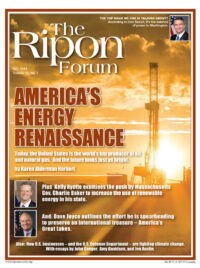
America has become a global energy superpower. That statement would have been unimaginable even a few years ago. For many years, our mindset was one of energy scarcity and vulnerability. We were building terminals to import energy from overseas, often times from nations that didn’t share our values.
But over the last 10 years, the application of hydraulic fracturing, horizontal drilling, and advanced seismic imaging technologies have unlocked vast quantities of oil and natural gas trapped in shale formations, leading to a 60% jump in production, a real energy renaissance. Because of the shale revolution, the United States has ushered in an era of energy abundance leading to greater energy self-sufficiency, lower costs, reduced emissions, and better energy security than at almost any other time in modern history.
Today, the United States is the world’s top producer of oil and natural gas. And the future looks just as bright. The U.S. Energy Information Administration (EIA) is forecasting that domestic crude oil production will soon surpass 11 million barrels per day and fluctuate between 11 and 12 million barrels per day out to 2050—a sustained rate 2 million barrels per day higher than the previous U.S. record of 9.6 million barrels per day set in 1970. Natural gas production also shows no sign of slowing down, with EIA projecting a 58 percent increase output by 2050. The United States is poised to become a large exporter of both fuels. Renewable energy is making substantial gains, and energy efficiency also continues to thrive in all sectors of the economy.
North America has now emerged as an energy center rivaling the Middle East and Russia and helped to stabilize global energy markets.
America’s energy revolution has given U.S. businesses a critical leg up in today’s intensely competitive global economy. American industry pays two to four times less for natural gas and electricity than its many competitors in places like Europe and Japan, a difference that is helping to drive a U.S. manufacturing revival.
Affordable energy is not only important in revitalizing U.S. manufacturing, it is also critical to improving America’s geopolitical posture. Indeed, North America has now emerged as an energy center rivaling the Middle East and Russia and helped to stabilize global energy markets. It is no surprise, then, that the United States since 2008 has risen from ninth to second place in the Global Energy Institute’s latest Index of International Energy Security Risk, a tool designed to facilitate a better understanding of global energy markets.
There are many reasons why the shale revolution occurred in the United States and not elsewhere. The technologies were invented here, and in many areas of the country the necessary infrastructure and skilled workforce were in place. America’s entrepreneurial culture also was a factor.
Make no mistake: the energy renaissance took hold in spite of federal policy, not because of it.
Perhaps the biggest factor in the success of the shale revolution was something that is seemingly unique to the United States: landowners also own the rights to the minerals beneath their land. Because of this, the shale revolution initially played out almost exclusively on private land and subject to state regulation. Given the hostility of the previous administration to hydrocarbon fuels, it’s quite likely that we would not be talking about the shale revolution at all had these resources been confined to federal lands. Indeed, while oil and gas output on private land has roared ahead, output on federal lands has remained sluggish. Make no mistake: the energy renaissance took hold in spite of federal policy, not because of it.
Maintaining America’s energy edge means moving from an energy policy developed for an era of energy scarcity to one of energy abundance. To that end, some progress is being made. The Chamber and others led the fight to end the ban on crude oil exports, and the Trump Administration has moved swiftly to get rid of some of the worst regulatory excesses of the previous administration and expand access to energy resources. The tax reform package was another bit of needed reform, which will result in lower costs for consumers.
One of the biggest obstacles to maintaining momentum in the energy space is the time and effort it takes to build the infrastructure needed to move molecules and electrons from where they are produced to where they are needed. We can have all the supply in the world, but without adequate infrastructure to move them, our energy edge will be squandered.
Unfortunately, environmental groups have become very good at using, and sometimes abusing, the legal system to tie up the construction of pipelines, transmission lines, export facilities, and other crucial infrastructure in “green tape.” If you can’t move it, you can’t produce it. This is becoming more and more critical. About half of the distribution pipes in the country are 50 years old or older. In some regions of the country, like New England, shifts to natural gas for power generation are limited because of constraints on pipeline capacity. In fact, last winter, the lack of pipeline infrastructure in New England led to the region importing natural gas from Russia, rather than the nearby states of Ohio and Pennsylvania.
Energy infrastructure uses a lot of iron and steel, and the imposition of tariffs on these goods could impose significant added costs on building this much needed infrastructure.
While we support reasonable regulations and a fair, transparent and thorough permitting process, we also need to ensure that needed infrastructure is able to be built in a timely manner. The Trump Administration is doing what it can to improve the process used for siting and permitting of energy projects, but Congress must act to ensure an open and predictable process that can’t be manipulated to delay, delay, delay.
We also are concerned that tariffs could blunt America’s energy edge. Energy infrastructure uses a lot of iron and steel, and the imposition of tariffs on these goods could impose significant added costs on building this much needed infrastructure. Retaliatory tariffs being contemplated or levied by our trading partners, many of which are large purchasers of U.S. energy, could affect exports of U.S. oil, natural gas, and coal.
One thing we should have learned over the past decade is that a strong energy sector is essential to a strong U.S. economy. Our energy entrepreneurs have made the United States the largest energy producer in the world. With a sensible policy environment that plays to America’s strengths, there is no reason we cannot maintain our energy edge and expand its benefits for every American.
Karen Alderman Harbert is president and chief executive officer of the U.S. Chamber of Commerce’s Global Energy Institute.




